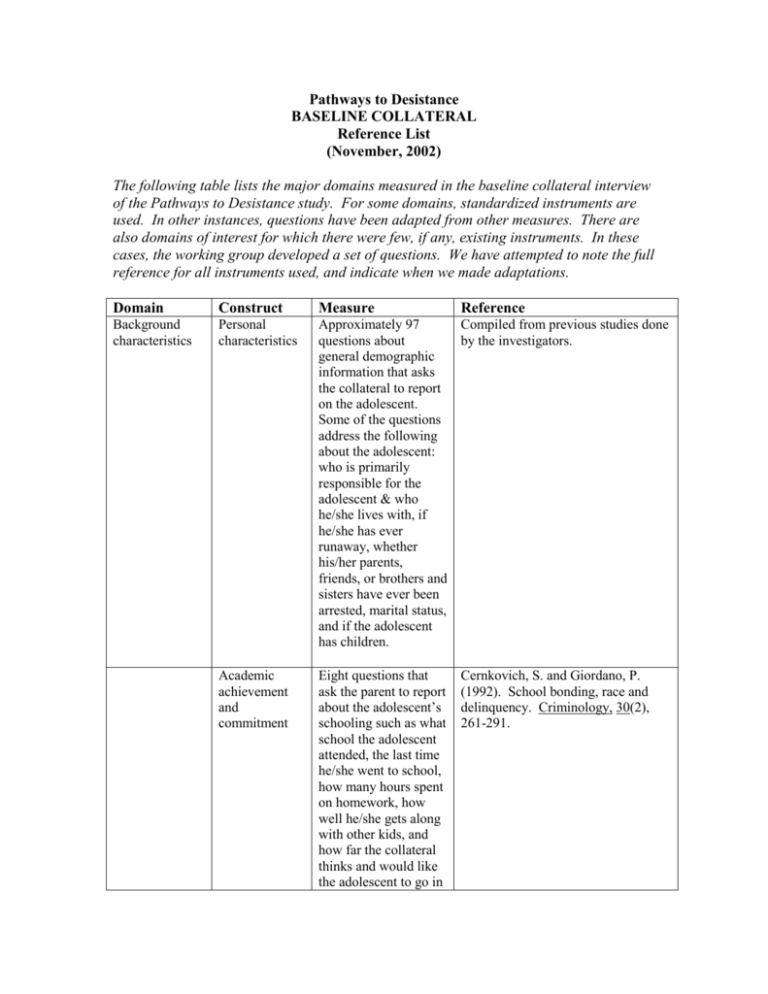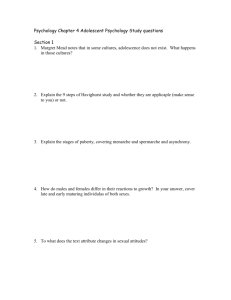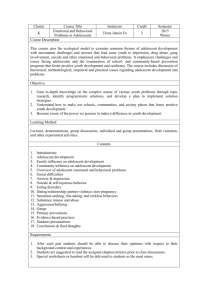Baseline Collateral Reference List
advertisement

Pathways to Desistance BASELINE COLLATERAL Reference List (November, 2002) The following table lists the major domains measured in the baseline collateral interview of the Pathways to Desistance study. For some domains, standardized instruments are used. In other instances, questions have been adapted from other measures. There are also domains of interest for which there were few, if any, existing instruments. In these cases, the working group developed a set of questions. We have attempted to note the full reference for all instruments used, and indicate when we made adaptations. Domain Construct Measure Background characteristics Personal characteristics Approximately 97 Compiled from previous studies done questions about by the investigators. general demographic information that asks the collateral to report on the adolescent. Some of the questions address the following about the adolescent: who is primarily responsible for the adolescent & who he/she lives with, if he/she has ever runaway, whether his/her parents, friends, or brothers and sisters have ever been arrested, marital status, and if the adolescent has children. Reference Academic achievement and commitment Eight questions that ask the parent to report about the adolescent’s schooling such as what school the adolescent attended, the last time he/she went to school, how many hours spent on homework, how well he/she gets along with other kids, and how far the collateral thinks and would like the adolescent to go in Cernkovich, S. and Giordano, P. (1992). School bonding, race and delinquency. Criminology, 30(2), 261-291. school. Offense history The collateral reports if the adolescent has done 24 different antisocial and illegal activities that range from destroying or damaging property, setting fires, stealing, selling drugs, carrying a gun, to killing someone. For those that the subject has done, the collateral reports how old the adolescent was when the he/she first did the act, how many times he/she has done this in the past year, and when the last time the act occurred. Adapted from: History of social services The collateral reports on sixteen different items that inquire about the different types of services the adolescent has received in social services, juvenile justice, and the mental health system. Some of the services are alcohol/drug treatment, psychiatric treatment, hospitalizations, foster care, family counseling, detention/prison/jail stays, and priest, minister, or clergy visitations. The inventory of services was adapted from services research projects done regarding adolescent services. The categories of services were based on those used in Burns, B, Angold, A., Magruder-Habib, K., Costello, E., and Patrick, M. (1994). The Child and Adolescent Services Assessment (CASA). Exposure to violence The collateral indicates the frequency the adolescent has been a witness or victim to different violent acts Selner-Ohagan, M., Kindlon, D., Buka, S., Raudenbush, S., and Earls, F. (1998). Assessing exposure to violence in urban youth. Journal of child Psychology and Psychiatry and Elliot, D.S. (1990). National Youth Survey. Institute of Behavioral Science. University of Colorado. Huizinga, D., Esbensen, F., and Weihar, A. (1991). Are there multiple paths to delinquency? Journal of Criminal Law and Criminology, 82, 83-118. Psychopathy such as: sexual attacks, attacks with weapons, shootings, and suicides. allied Disciplines, 39(2), 215-224. The YPI is a self report measure of psychopathy that asks 50 questions that contain several subscales: dishonest charm, grandiosity, lying, manipulation, remorselessness, unemotionality, callousness, thrill seeking, impulsiveness, and irresponsibility. The collateral is asked to report on how well each statement applies to the adolescent. For the YPI: Andershed, Kerr, & Stattin (in press). YPI, Version 3.0, Center for Developmental Research, Orebo University, Sweden. The PCL-YV attempts to assess the presence of psychopathy in youth via a semistructured interview. In this interview, the collateral is used to supplement the adolescent's own report. The interview consists of approximately 44 questions that asks the collateral’s view on the adolescent in order to assess the adolescent’s interpersonal style, obtain information on a variety of aspects of his/her history and current functioning and attempt to assess the credibility of For the PCL: Forth, A., Kossen, D., and Hare R., (in preparation). The Hare Psychopathy Checklist: Youth Version. Multi-Health Systems, Inc. New York. his/her statements. The interview covers: educational, occupational and family backgrounds; psychological factors; interpersonal relationships; history of antisocial behaviors; attitudes toward self and others; and goals for the future. 20 items are scored using a 3-point ordinal scale. Two factor scores (interpersonal/affective and socially deviant lifestyle) plus a total score are derived from these 20 items. Emotional reactivity Disruptive behavioral The EASI contains 14 questions to assess how overwhelmed the adolescent becomes in emotional situations. The collateral is asked to report on the adolescent by indicating how much he/she agrees or disagrees with each question. For the EASI: Buss, A. H., and Plomin, R. (1975). A temperament theory of personality development. New York, NY: WileyInterscience. The Walden is a 12 item positive and negative emotionality measure that asks the collateral’s views on the adolescent’s ability to control feelings, calm oneself down, and make oneself happy or sad. For the Walden: Walden, T., Lemerise, E., and Gentile, J. (1992, April). Emotional competence and peer acceptance among preschool children. Paper presented at the Conference on Human Development, Atlanta, GA. Forty-two item measure to assess the Pelham, W. E. Gangy, E., Greenslade, K., Milich, R. (1992). Buss, A. H., and Plomin, R. (1984). Temperament: early developing personality traits. Hillsdale, NJ: Erlbaum. disorder Psychological mediators parent’ view of attention deficit/hyperactivity disorder in the adolescent. Questions address the current time period and the elementary school years. Psychological development Three subscales from the Weinberger Adjustment Inventory are used to assess socio-emotional development: impulse control (8 items), suppression of aggression (7 items), and consideration of others (7 items). The collateral’s opinion is given on how he/she thinks the adolescent usually feels or acts. Perceptions of opportunity A series of 7 items about how much the collateral believes that the adolescent can do well later in life. Teacher ratings of DSM-III-R symptoms for the disruptive behavior disorders. Journal of the American Academy of child and Adolescent Psychaitry, 31, 210-128. See also: DuPaul, G.J., Anastopoulos, A.D., Power, T.J., Reid, R., Ikeda, M.J., & McGoey, K.E. (1998). Parent ratings of attention-deficit/hyperactivity disorder symptoms: Factor Structure and Normative Data. Journal of Psychopathology and Behavioral Assessment. 20(1), 83-102. For the Weinberger Adjustment Inventory: Weinberger, D.A., and Schwartz, G.E. (1990). Distress and restraint as superordinate dimensions of selfreported adjustment: a typological perspective. Journal of Personality, 58(2), 381-417. These questions were revised from the set used in the National Youth Survey – Prediction of Adult Success (Menard & Elliott, 1996). Menard, S. and Elliott, D. S. (1996). Prediction of adult success using stepwise logistic regression analysis. A report prepared for the MacArthur Foundation by the MacArthur Chicago-Denver Neighborhood Project. Elliott, D.S., (1990). National Youth Survey. Institute of Behavioral Science. University of Colorado. Perceptions of procedural justice Sixteen questions that ask the collateral’s opinions about the These questions were adapted from several studies of perceptions of procedural justice in adults. General adolescent’s perception of fairness and equity connected with arrest and court processing. The scale focuses primarily on police, judges, legitimacy of the law, and legal cynicism. references are: Casper, J., Tyler, T., and Fisher, B. (1988). Procedural justice in felony cases. Law and Society Review, 22(3) 483-507. Tyler, T.R. (1990). Why People Obey the Law. New Haven: Yale University Press. Dimensions of Representativeness, Consistency, Correctability, Neutrality, Legitimacy are based upon: Tyler, T. (1997). Procedural fairness and compliance with the law. Swiss Journal of Economics and Statistics, 133 (2/2), 219-240. Paternoster, R., Brame, R., Bachman, R., and Sherman, L.W. (1997). Do fair procedures matter? The effect of procedural justice on spouse assault. Law and Society Review, 31, 163204. Dimension of Legal Cynicism is based upon: Srole, L. (1956). Social integration and certain corollaries: An exploratory study. American Sociological Review, 21, 709-716. Sampson, R.J. and Bartusch, D.J. (1999). Legal cynicism and tolerance of deviance: the neighborhood context of racial differences. Law and Society Review, 32(4), 777-804. Family Context Religious orientation One question asking the collateral how often the adolescent attended religious services during the past year. Maton, K.I., Teti, D., Corns, K., Vieira-Baker, K., Lavine, J., Gouze, K.R., and Keating, D. (1996). Cultural specificity of social support sources, correlates and contexts: Three studies of African-American and Caucasian youth. American Journal of Community Psychology, 24, 551-587. Family The collateral responds The questions were adaptations of relationships Community Context to 9 items about their level of involvement in supervising the adolescent and the affective tone of the parent/adolescent relationship those used in earlier studies with adolescents. Parent orientation The collateral reports his/her views on three statements to assess the importance of the youth’s role as a parent. Silverberg, S., and Steinberg, L. (1990). Psychological well-being of parents with early adolescent children. Developmental Psychology, 26, 658-666. Neighborhood conditions Twenty-one questions that probe for the collateral’s perspective of observable indicators of high social disorganization in the adolescent’s neighborhood. Elliott, D., Menard, S., Rankin, B., Elliott, A., Huizinga, D., and Wilson, W. (forthcoming). Beating the Odds: Overcoming Disadvantage in HighRisk Neighborhoods. For Parental Monitoring: Steinberg, L, Dornbusch, S, and Darling, N. (1992). Impact of parenting practices on adolescent achievement. Authoritative parenting, school involvement, and encouragement to succeed. Child Development, 63, 1266-1281. Elliott, D.S., Wilson, W.J., Huizinga, D., Sampson, R.J., Elliott, and Rankin, B. (1996). The effects of neighborhood disadvantage on adolescent development. Journal of Reseach in Crime and Delinquency, 33(4), 389-426. Sampson, R, and Raudenbush, S. (1999). Systematic social observation on public spaces: a new look at disorder in urban neighborhoods. American Journal of Sociology, 105(3), 603-651. Sampson, R., Raudenbush, S., and Earls, F. (1997). Neighborhoods and violent crime: a multilevel study of collective efficacy. Science, 277, 918-924. Sampson, R., (1997). Collective regulation of adolescent misbehavior: validation results from eighty Chicago neighborhoods. Journal of Adolescent Research, 12(2), 227-244. Community involvement Nine questions that ask the collateral about whether the adolescent has active involvement in structured community activities and an assessment of how the adolescent usually spends time in the community. The items about involvement in community organizations were adapted from those used in the National Youth Survey (see Involvement in Conventional Social Contexts by Menard & Elliott, 1996). Elliot, D.S., (1990). National Youth Survey. Institute of Behavioral Science. University of Colorado. Horney, J., Osgood, W., and Marshall, L. (1995). Criminal careers in the short-term: intraindividual variability in crime and its relation to local life circumstance. American Sociological Review, 60(5), 655-673. Personal capital and social ties The collateral is asked to report his/her view on sixteen items that assess community structures. Questions address whether or not the collateral knows the adolescent’s friends and parents of friends, how willing neighbors are to help others in the neighborhood, what the chances are of getting a good job in the neighborhood, and if neighbors attend community block groups and religious services. Nagin, D. S., and Paternoster, R. (1994). Personal capital and social control: the deterrence implications of a theory of individual differences of offending. Criminology, 32, 581673. Williams, H.R., and Hawkins, R. (1986). Perceptual research on general deterrence: A Critical Overview. Law and Society Review, 20, 545-572. Grasmick, H.G. and Bursik, R.J., Jr. (1990). Conscience, significant others, and rational choice: extending the deterrence model. Law and Society Review, 24, 837-861.






